
Quickly to the right hardware equipment …
Layout, design and features
ASRock B650E Taichi Lite Chipset
ASRock B650E Taichi Lite Expansion cards
ASRock B650E Taichi Lite Memory modules
ASRock B650E Taichi Lite Drive Connectors
ASRock B650E Taichi Lite USB
ASRock B650E Taichi Lite Network
ASRock B650E Taichi Lite Sound
ASRock B650E Taichi Lite RGB Lighting
ASRock B650E Taichi Lite ATX Equipment and other features
ASRock B650E Taichi Lite PC System
Now it’s time to take a closer look at the ASRock B650E Taichi Lite.
Layout, design and features …
The ASRock B650E Taichi Lite is based on a high-quality high-density fiberglass 8-layer PCB and currently supports all AMD Ryzen Zen4 CPUs of the 7000, 7000X and 7000X3D series. If AMD stays true to its promise, future CPUs with the AM5 socket will also be supported until 2025.
The ASRock B650 Taichi Lite has the same 24+2+1 Premium 105A Smart Power Stages (SPS) and Nichicon 12K Black Caps capacitors as the X670E Taichi and the B650E Taichi. Despite the lower price, ASRock retains the dramatically oversized VRM section, so you don’t have to worry about whether the board can provide enough power for overclocking. No other AM5 motherboard on the market offers a comparatively strong VRM assembly like the one ASRock has integrated on its high-end boards. The VRM coolers have been shrunk slightly and the fan hidden behind the rear I/O panel has been removed. In our previous tests of the X670E Taichi and the B650E Taichi, the mini fan always remained silent, which is why we cannot speak of any real deterioration of the VRM design.
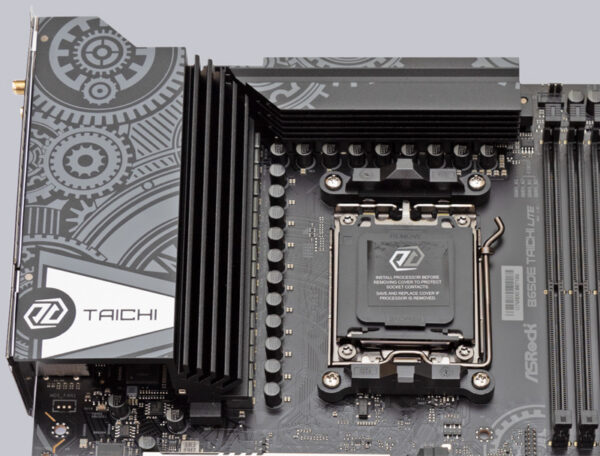
Fortunately, nothing has changed in the audio section either. The tried-and-tested 5.1 HD audio via the Realtek ALC4082 codec and ESS SABRE9218 DAC with Nahimic Audio support and WIMA audio caps has been retained. The B650E Taichi Lite also has a Blazing M.2 slot for PCIe Gen5 x4 modules with up to 128 Gb/s connection, which is located to the right of the four DDR5 slots. Several Gen5 NVMe SSDs are now available on the market. These achieve sequential read rates of up to 12385MB/s and write rates of up to 11825MB/s, as our Review of the Crucial T700 revealed. Two additional Hyper M.2 slots for PCIe Gen4 x4 modules with up to 64 Gb/s are located between the two PCIe x16 slots, of which the lower one is only connected to the CPU with 4 lanes (x4). Passive heat sinks are already pre-assembled for all M.2 slots, with captive mounting screws. This saves a lot of trouble when installing the cooler. Unfortunately, there are no practical quick-release fasteners for attaching the M.2 SSDs. The Gen5 slot is compatible with module sizes from 2230 to 22110, while the two Gen4 slots accept 2280 modules, as is common with most M.2 SSDs. Here you can see a Crucial P3 PCIe Gen3 x4 2280 SSD in the M.2 Gen5 slot.
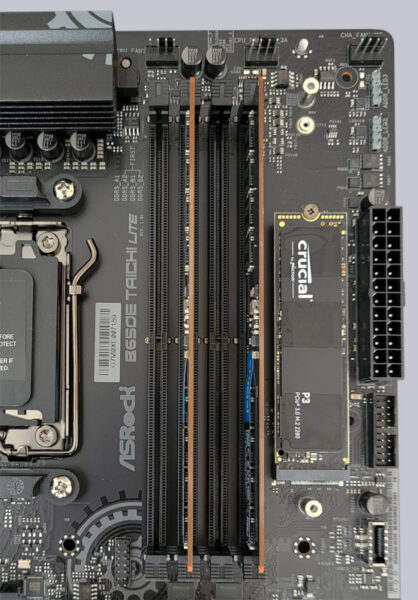
The two M.2 Gen4 slots are covered by a passive heat sink. Unfortunately, access is covered when a graphics card is used in the upper PCIe x16 slot. Above the Promontory chipset there is now only a significantly reduced, passive heat sink.
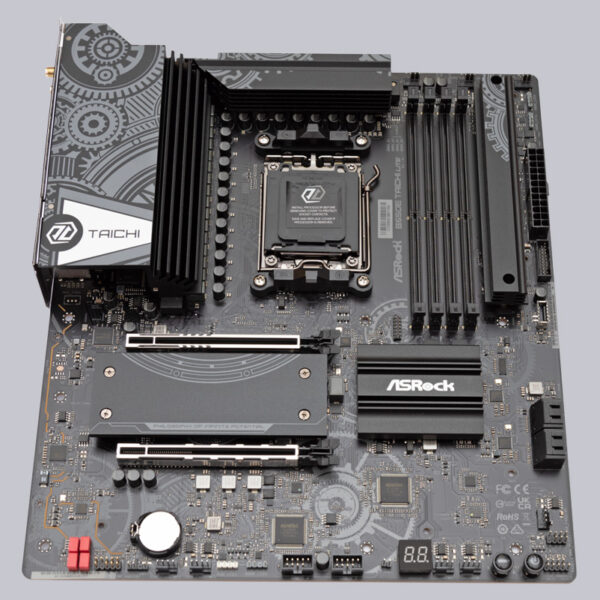
Chipset …
The heart of the ASRock B650E Taichi motherboard is the B650 Extreme chipset from AMD. X670 and B650 chipsets differ less than you might think. A single Promontory-21 chip is used on B650 boards, whereas two Promontory-21 chips are used on X670 boards. This means that B650 and X670 boards basically offer the same functions, but the second Promontory-21 chip on X670 boards enables more high-speed connections to the CPU for additional M.2 slots, PCIe slots or USB sockets. The entry-level A620 chipset has also been available for a few months. Below is an overview of how AMD has planned the connection of the interfaces. A different design by the board manufacturer is possible.
| AMD AM5 Chipset Comparison | ||||||
| Chipset | PCIe total | PCIe Gen5 | USB 3.2 Gen1 | USB 3.2 Gen2 | USB 3.2 Gen2x2 | SATA |
| X670E | 44 | 24 | 2 | 12 | 2 | 8 |
| X670 | 44 | 8 | 2 | 12 | 2 | 8 |
| B650E | 36 | 24 | 1 | 6 | 1 | 4 |
| B650 | 36 | 0 | 1 | 6 | 1 | 4 |
| A620 | 32 | 0 | 2 | 2 | 0 | 4 |
Expansion cards …
The upper of the two steel-reinforced PCIe X16 slots is a Gen 5 slot. The lower slot is only connected with 4 PCIe lanes of the 4th generation. Here we see the two PCIe slots flanking the two M.2 Gen4 slots, which are only compatible with size 2280, as is common with NVMe SSDs.
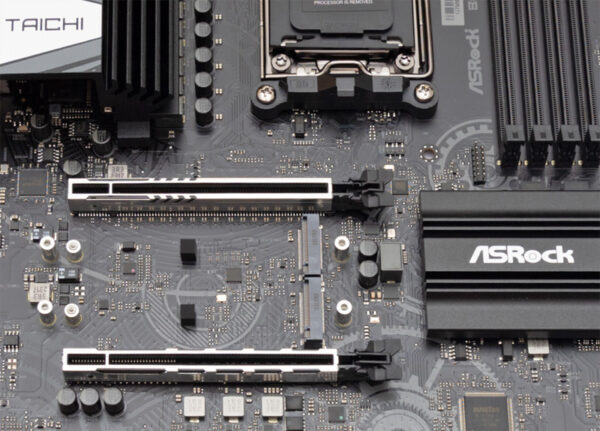
Memory modules …
The B650E Taichi Lite currently supports up to 192GB DDR5 RAM, as a recent BIOS/UEFI update has added support for the new 24Gbit memory chips, allowing memory modules with up to 48GB capacity to be manufactured in dual rank design.
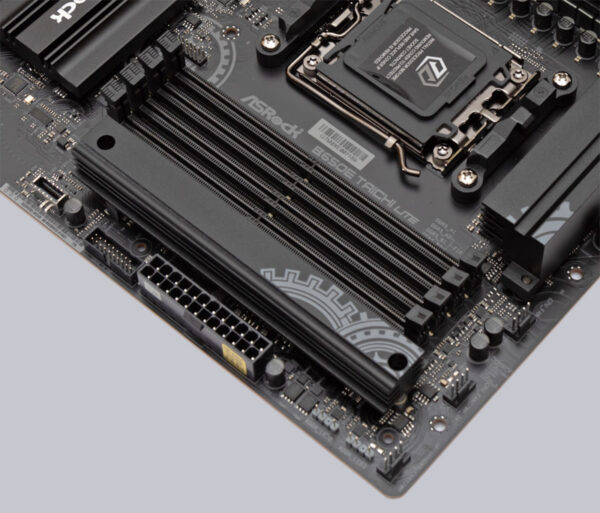
Drive connectors …
A total of four angled SATA3 ports with 6 Gb/s are available for optical drives and hard disks/SSDs, which are connected to the CPU via an ASMedia AS1061 chip. Raid modes 0, 1 and 10 are supported on both the SATA ports and the M.2 ports. The necessary programs for RAID configuration and installation are available for download on the ASRock website.
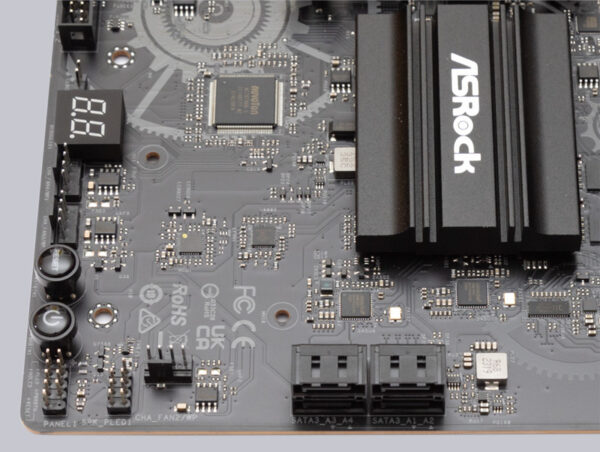
USB …
As befits a top motherboard, the ASRock B650E Taichi Lite is not stingy with the number of USB ports. A total of 11 Type-A sockets and one USB-C socket are available on the rear I/O panel. The USB-C port delivers maximum transfer rates of up to 40 Gb/s and a charging capacity of up to 27W (9V/3A) in accordance with the PD 3.0 Quick Charge standard for mobile devices or battery packs. This means that even a wireless gamepad or cell phone can be recharged in no time at all. There are also three USB-A 3.2 Gen 2 sockets with 10 Gb/s, two of which run via their own controller and have the lowest latencies for mouse and keyboard for eSports professionals and ambitious hobby gamers. They have yellow inlays and are labeled “Lightning Gaming”. The remaining eight USB type A sockets transfer up to 5Gb/s in accordance with the USB3.2 Gen1 standard.
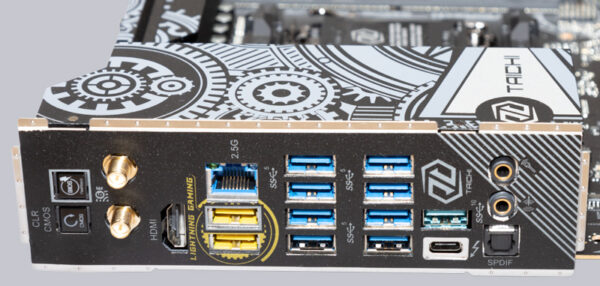
If that’s not enough, the number of usable USB ports can be significantly expanded. There are two headers for a total of four USB 2 ports (480 Mb/s), one header for two USB 3.2 Gen 1 ports (5 Gb/s) and one header for a USB 3.2 Gen 2×2 header for front USB-C with 20 Gb/s. The motherboard also comes with a slot bracket with 2 USB-A sockets, which according to ASRock is best used for WLAN or Bluetooth dongles.
Network …
The ASRock B650E Taichi Lite also has the Killer E3100G chip installed, which enables LAN connections of up to 2.5Gb/s. In addition, the motherboard has an integrated Killer AX1675 chip. This allows connections to be established via the enclosed antenna in accordance with WiFi 6E (6GHz, 160MHz, dual band 2×2) and Bluetooth 5.2 standard. Of course, older connection modes according to IEEE 802.a/b/g/n/ac are also supported. Network traffic can be optimized with the Killer LAN software and Killer DoubleShot Pro, which results in a theoretical maximum total bandwidth of up to 4.9 Gb/s when using LAN and WLAN simultaneously.
Sound …
Of course, the B650E Taichi Lite doesn’t miss out on sound either. The motherboard is equipped with a Realtek ALC4082 5.1 HD audio codec and ESS Sabre9218 DAC. Thanks to WIMA audio caps, separate channel shielding on the PCB and Nahimic audio support, the signal-to-noise ratio is a considerable 130dB. The audio section also features impedance detection, which means that the use of both low-impedance and high-impedance headphones with up to 600 ohms is no problem. For 5.1 sound via a jack, an additional jack socket must be connected to the housing via the internal audio header, the contacts of which are even gold-plated. There is also an optical S/PDIF output on the rear I/O panel.
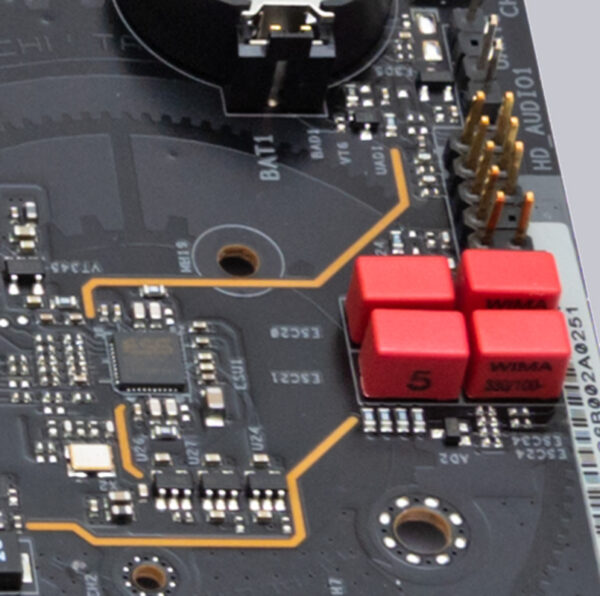
RGB lighting …
Compared to the B650E Taichi, the design of the PCB and the heat sink on the Taichi Lite has been made a little less conspicuous, but the Lite is still an eye-catcher. The RGB logo of the chipset cooler has been omitted, but the addressable RGB LEDs at the bottom right of the rear of the motherboard have been retained. Although the scatter bar has also been omitted, the LEDs shine out strongly and evenly from the side. To expand the RGB lighting, three pin headers for connecting 5V aRGB elements and a 4-pin RGB (12V) pin header are available on the motherboard.
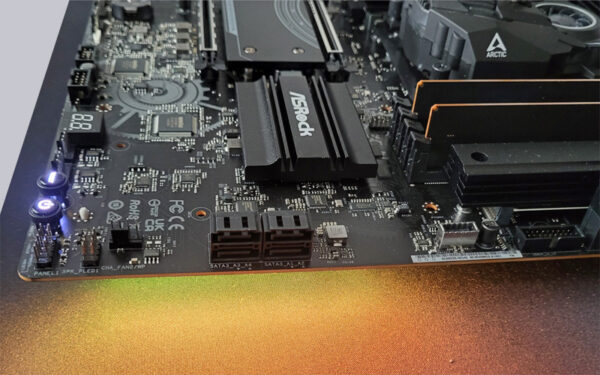
All RGB LEDs connected to the motherboard can be controlled via the UEFI BIOS or the Polychrome Sync RGB software provided by ASRock. For optimal control of the addressable LEDs, the number of connected LEDs for each port can be specified in the program.
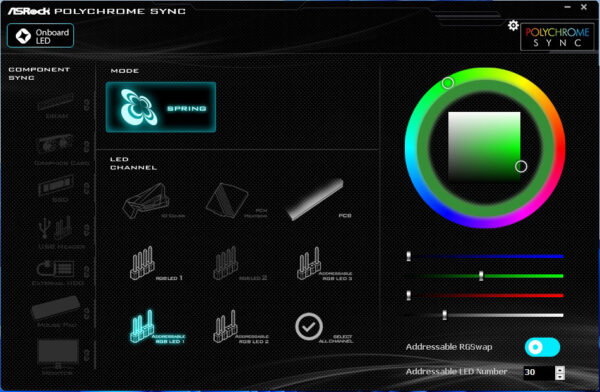
Equipment and other features …
The ASRock B650E Taichi has numerous useful features, such as the ASRock A-Tuning Tool, ASRock Instant Flash, BIOS Flashback, NVMe Sanitization Tool, SSD Secure Erase Tool, Digi Power, ASRock RGB LED, ASRock Polychrome RGB and ASRock FAN-Tastic Tuning, Blazing OC Tuner, Killer Doubleshot Pro, PD 3.0 Quickcharge, Lightning Gaming USB Ports, Auto Driver Installer.
The BIOS flashback function is particularly noteworthy here, as the AM5 platform is also designed for future CPU generations, but their specifications cannot yet be stored in the BIOS and will only be added later when the new CPUs are released. The necessary BIOS update can then be carried out using a USB stick without a CPU being present.
Test System …
For the test of the ASRock B650E Taichi Lite we use an AMD Ryzen 5 7600X CPU and 2x 16GB DDR5-5600 from Crucial.
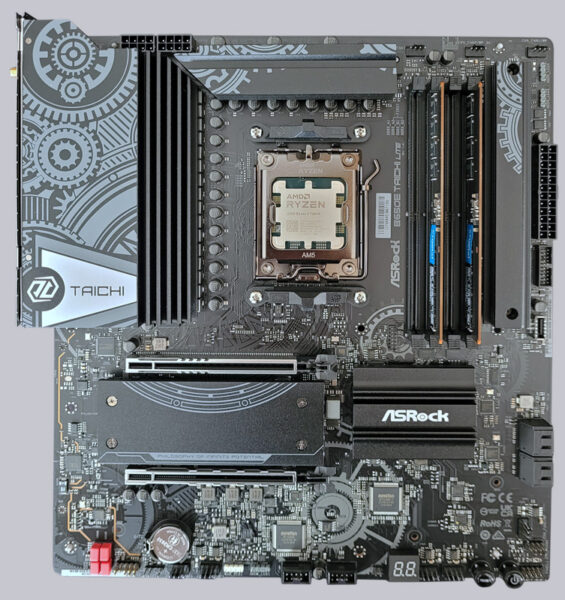
For cooling, we rely on the tried and tested all-in-one water cooling system from Arctic, namely the Liquid Freezer II 280 A-RGB, which can be used with the previous AM4 bracket on the ASRock B650E Taichi Lite without any modifications. For the thermal paste, we also rely on a product from Arctic, namely the new MX-6 paste. Its thermal conductivity is excellent (see thermal paste comparison test), it does not dry out even after a long period of operation and is electrically non-conductive, which is an advantage with the new AM5 CPUs because it has exposed SMD components on the top.
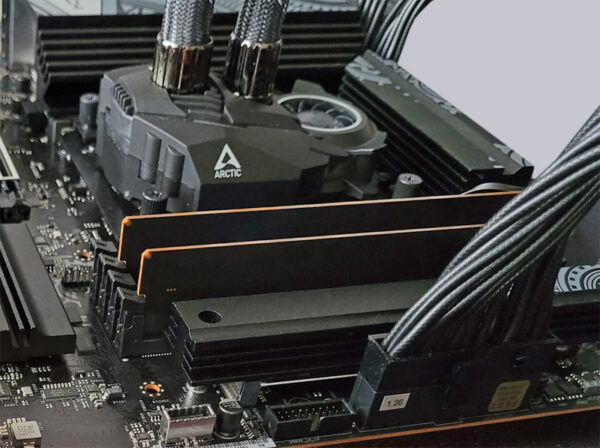
The necessary power is provided by the Seasonic Vertex GX850 80+ Gold ATX3.0 power supply, which was recently fully convincing in the test and provides more than sufficient power reserves for the 105W CPU with integrated graphics unit.
ASRock B650E Taichi BIOS and Overclocking …

